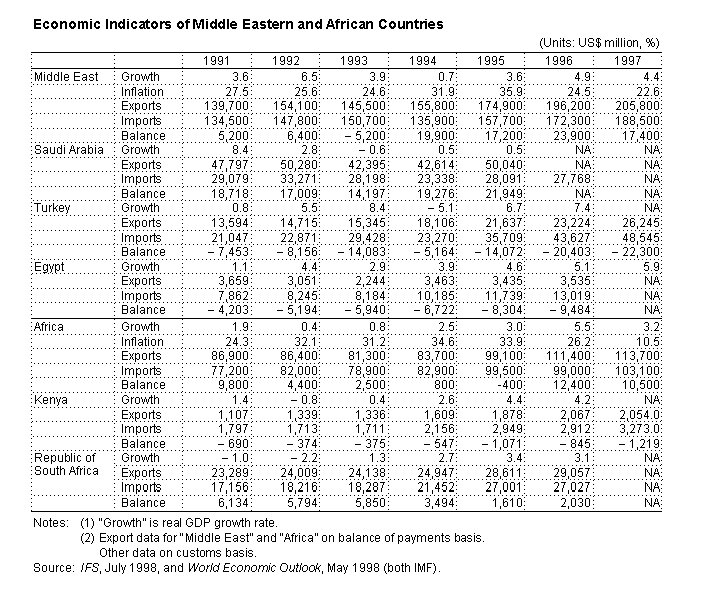JETRO WHITE PAPER ON INTERNATIONAL TRADE 1998
Japan External
Trade Organization (JETRO)
5. Middle East and Africa
(1) Middle East
[1] Trends in Trade
The real GDP growth rate of the Middle East (17 countries including Egypt,
Libya, Malta, Cyprus and Turkey but excluding Israel) slowed slightly from 4.9%
in 1996 to 4.4% in 1997. With the slump in oil prices from October 1997, however,
countries such as the United Arab Emirates (UAE), Oman and Iran suffered a slowdown
in economic growth due to the fall in the value of crude oil exports. As a result,
the Middle East's exports grew by 4.9% on the previous year to US$205.8 billion,
far below the 12.2% growth registered in 1996. Nevertheless, imports continued
their upward trend by growing 9.4% on the previous year to US$188.5 billion.
[2] Changes in Trade Environment
With demand down in Asia and Iraq expected to expand production, there is
now little possibility of a rise in oil prices, and the serious economic impact
that this will have on oil producers, particularly on exports, is unavoidable.
Positive action is being taken to liberalize intra-regional and extra-regional
trade; in January 1998, certain countries began to take steps to progressively
eliminate tariffs among them preparing for the creation of a common Arab market
in 2007, while following on from Jordan's alliance with the EU in 1997, Egypt
is expected to enter a free trade agreement with the EU in 1998. However, there
is little chance of any substantial improvement in economic and trade relations
between the Arab nations and Israel due to the Middle East peace negotiations
having come to a standstill.
[3] Developments in Trade with Japan
Japan's trade with the Middle East (15 countries including Turkey and Israel
but excluding Egypt, Libya, Malta and Cyprus) grew, with exports up 12.9% on the
previous year to US$12.29 billion and imports up 8.5% to US$38.52 billion. Exports
were pushed up by the 24.0% recovery in exports of automobiles, which account
for 40% of exports, from the previous year*s level. This resulted from the recovery
of price competitiveness as the yen weakened. Imports rose 7.8% on the previous
year in terms of value due to a 5.8% increase in the volume of oil imports, which
comprise 70% of imports, but the effects of the slump in oil prices from October
1997 led to a rate of growth below the 14.6% registered in 1996.
(2) Africa
[1] Trends in Trade
The real economic growth rate of the African region (including the countries
of North Africa but excluding Egypt and Libya) fell 2.3 percentage points on the
previous year to 3.2%. This was due to depressed agricultural production resulting
from unseasonable weather conditions and a slump in the international prices of
primary products. However, exports continued their rise from 1996, growing by
2.1% on the previous year to US$113.7 billion, and imports grew by 4.1% to US$103.1
billion.
[2] Changes in Trade Environment
While African nations are maintaining their trade with their former European
suzerains, trade is also growing with the U.S. and China, who have come to regard
the African nations as new economic partners. China is seeking to increase exports
to Africa to make up for the decline in exports to Asia, where the currency and
economic crisis has caused a recession. The importance of the African nations
as trading partners is also increasing in the U.S. The U.S. is making positive
efforts to expand trade with African nations by, for example, approving the "African
Growth Opportunity Bill" that would make exports of African products to the U.S.
tax exempt for 10 years.
[3] Developments in Trade with Japan
Regarding Japan's trade with the sub-Saharan nations (the 47 countries south
of the Sahara excluding Sudan), exports fell by 13.9% on the previous year to
US$4.12 billion and imports fell by 2.5% to US$4.31 billion. The trade balance
showed Japan*s deficit of US$190 million, its first in the past decade. The main
causes of the fall in exports were a 50.5% year-on-year fall in exports of ships
and 16.4% fall in exports of gearboxes and other auto parts. Apart from a rise
in imports of industrial products due to growth in platinum primary products,
imports fell in all categories. These included a 62.0% fall in maize, an 89.3%
fall in transport equipments, and a 7.3% fall in ferroalloy caused by a fall in
prices. 
Table of contents

